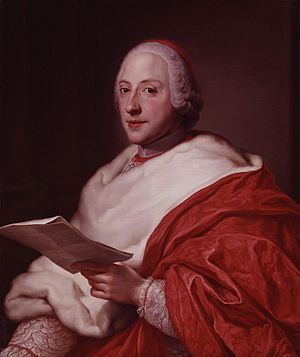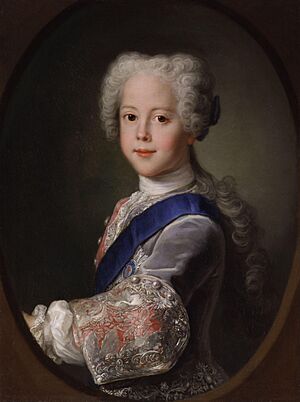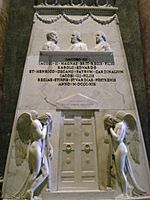Henry Benedict Stuart facts for kids
Quick facts for kids His Eminence Henry Benedict Stuart |
|
|---|---|
| Cardinal-Bishop of Ostia and Velletri and Dean of the College of Cardinals |
|

Portrait by Anton Raphael Mengs, c. 1750
|
|
| Province | Rome |
| Diocese | Ostia and Velletri |
| Appointed | 26 September 1803 |
| Reign ended | 13 July 1807 |
| Predecessor | Gian Francesco Albani |
| Successor | Leonardo Antonelli |
| Other posts |
|
| Orders | |
| Ordination | 1 September 1748 |
| Consecration | 19 November 1758 by Pope Clement XIII |
| Created Cardinal | 3 July 1747 |
| Personal details | |
| Birth name | Henry Benedict Mary Clement Thomas Francis Xavier Stuart |
| Born | 6 March 1725 Palazzo Muti, Rome, Papal States |
| Died | 13 July 1807 (aged 82) Frascati, Rome, Papal States |
| Buried | St. Peter's Basilica, Vatican City |
| Parents | |
| Previous post |
|
| Coat of arms | |
Henry Benedict Stuart (born March 6, 1725 – died July 13, 1807) was an important leader in the Catholic Church. He was also the last person from the House of Stuart family to publicly claim the thrones of Great Britain and Ireland. This claim was part of a movement called Jacobitism.
Unlike his father, James Francis Edward Stuart, and his brother, Charles Edward Stuart, Henry didn't try to become king. After his brother Charles died in 1788, the Pope did not recognize Henry as the rightful ruler of Great Britain and Ireland. Instead, the Pope referred to him as the Cardinal Duke of York.
Henry spent most of his life in the Papal States (parts of Italy ruled by the Pope). He had a long and successful career in the Catholic Church. He rose to become the Dean of the College of Cardinals, which is a very high position. He was also the Cardinal-Bishop of Ostia and Velletri. When he died, he was one of the longest-serving cardinals in the Church's history.
When Henry was young, his father gave him the title of Duke of York (a special title in the Jacobite family). He was best known by this title. After his brother died in 1788, Jacobites started calling Henry "Henry IX." However, he publicly called himself "Cardinal called Duke of York." This showed that while people knew him as the Duke of York, his main role was in the Church.
Contents
Henry's Early Life

Henry was born in Rome, Italy, on March 6, 1725. He was born in exile, meaning his family was living away from their home country. Pope Benedict XIII baptized him on the same day. This was 37 years after his grandfather, James II, lost the throne of England. It was also ten years after his father's failed attempt to get the throne back.
His father was James Francis Edward Stuart, who was sometimes called "the Old Pretender." His mother was Princess Maria Clementina Sobieska. She was the granddaughter of John III Sobieski, who was the King of Poland.
In 1745, Henry went to France to help his brother, Prince Charles Edward Stuart. Charles was also known as "Bonnie Prince Charlie" or "the Young Pretender." They were planning a Jacobite campaign to try and regain the throne. After this campaign failed, Henry Stuart went back to Italy.
On June 30, 1747, Pope Benedict XIV made Henry a Cardinal-Deacon. This happened in a special meeting on July 3, 1747. On August 27, 1747, the Pope gave him four minor church orders. He became a subdeacon on August 18, 1748, and a deacon on August 25, 1748. He was ordained as a priest on September 1, 1748. Later, on October 2, 1758, he became the titular Archbishop of Corinth.
In 1748, he was made a Cardinal Priest. On July 13, 1761, he became the Cardinal-Bishop of Frascati. When he became the most senior cardinal, known as the Dean of the Sacred College of Cardinals, on September 26, 1803, he moved to the See of Ostia and Velletri.
Life During the French Revolution
Henry was once a very wealthy man. He received a lot of money from his many church positions. His income from churches and other roles in places like Flanders, Spain, Naples, and France was about 40,000 Pounds in English money. He also earned money from other church benefits in Spanish America. He even owned land in Mexico, which added a lot to his income.
During the French Revolution, Henry lost the land and money that the French king had given him. He also spent a lot of his own money helping Pope Pius VI. On top of this, the French took over his property in Frascati. All these events caused him to become poor.
The British Minister in Venice helped Henry get a yearly payment of £4,000 from King George III of Great Britain. The British government said this was an act of kindness. However, Henry and the Jacobites believed it was the first payment of money that was legally owed to him. For many years, the British government had promised to return the English dowry of his grandmother, Mary of Modena, but they never did.
Henry returned to Frascati in 1803. In September of that year, he became the Dean of the College of Cardinals. This also made him the Cardinal Bishop of Ostia and Velletri. Even with these new titles, he continued to live in the bishop's palace at Frascati. He passed away there on July 13, 1807, at the age of 82.
Henry was the last person claiming the English throne to perform a special healing touch for a disease called the King's Evil.
After Henry's Death
In his will, which he signed as "Henry R," he said that his friend and closest blood relative, Charles Emmanuel IV of Sardinia, would inherit all his claims to the British throne. However, Charles never publicly claimed or denied these Jacobite claims, and neither have any of his family members since.
Many people mistakenly believe that Henry left the Crown Jewels to the Prince of Wales, who later became George IV of the United Kingdom. This is not true. All of Henry's property was given to Monsignor Angelo Cesarini to distribute. Cesarini did send the Prince of Wales several jewels from Henry's personal collection. These included a "Lesser George" badge, which is thought to have been worn by Charles I of England when he was executed. This badge is now at Windsor Castle. Cesarini also sent a St Andrew's Cross, which is a badge of the Order of the Thistle, now at Edinburgh Castle, and a ruby ring.
Henry Benedict, his brother, his father, and his mother are all buried in the crypt of St. Peter's Basilica in the Vatican. There is a monument to the Royal Stuarts designed by Antonio Canova in the main part of the basilica to remember them. This monument was recently cleaned and repaired, with the costs paid by Queen Elizabeth The Queen Mother.
Henry was a cardinal who could vote in papal elections. He participated in the elections of popes in 1758, 1769, 1774-75, and 1799-1800.
Images for kids
-
Henry Benedict Stuart by Maurice Quentin de La Tour (1746/47), once thought to be of Charles Edward Stuart
-
Henry Benedict Stuart by Anton Raphael Mengs (1756)
See also
 In Spanish: Enrique Benedicto Estuardo para niños
In Spanish: Enrique Benedicto Estuardo para niños





